Genetic Disorders and Complications: A Report for Medheal Hospital
VerifiedAdded on 2020/03/04
|8
|2707
|165
Report
AI Summary
This report provides a comprehensive overview of genetic disorders and their implications within the healthcare setting, specifically addressing concerns within the Medheal group of hospitals. It explores various genetic disorders, including Turner syndrome, sickle cell disease, and cystic fibrosis, and discusses the ethical implications of genetic testing, counseling, and screening. The report analyzes the barriers to advancements in genetic disorders, highlighting the importance of genetic tests, new medicines and quality treatment. It also covers the ethical considerations related to patient privacy, informed consent, and the potential for misuse of genetic information. The report further explores the use of karyotyping, amniocentesis, and other diagnostic techniques, while also addressing the ethical dilemmas surrounding prenatal testing and genetic counseling for both children and adults. Finally, the report emphasizes the need for ethical guidelines and regulations to ensure responsible use of genetic information and to protect the rights and welfare of patients. This report aims to guide healthcare professionals in addressing the challenges and opportunities presented by genetic disorders, ultimately improving patient care and outcomes.
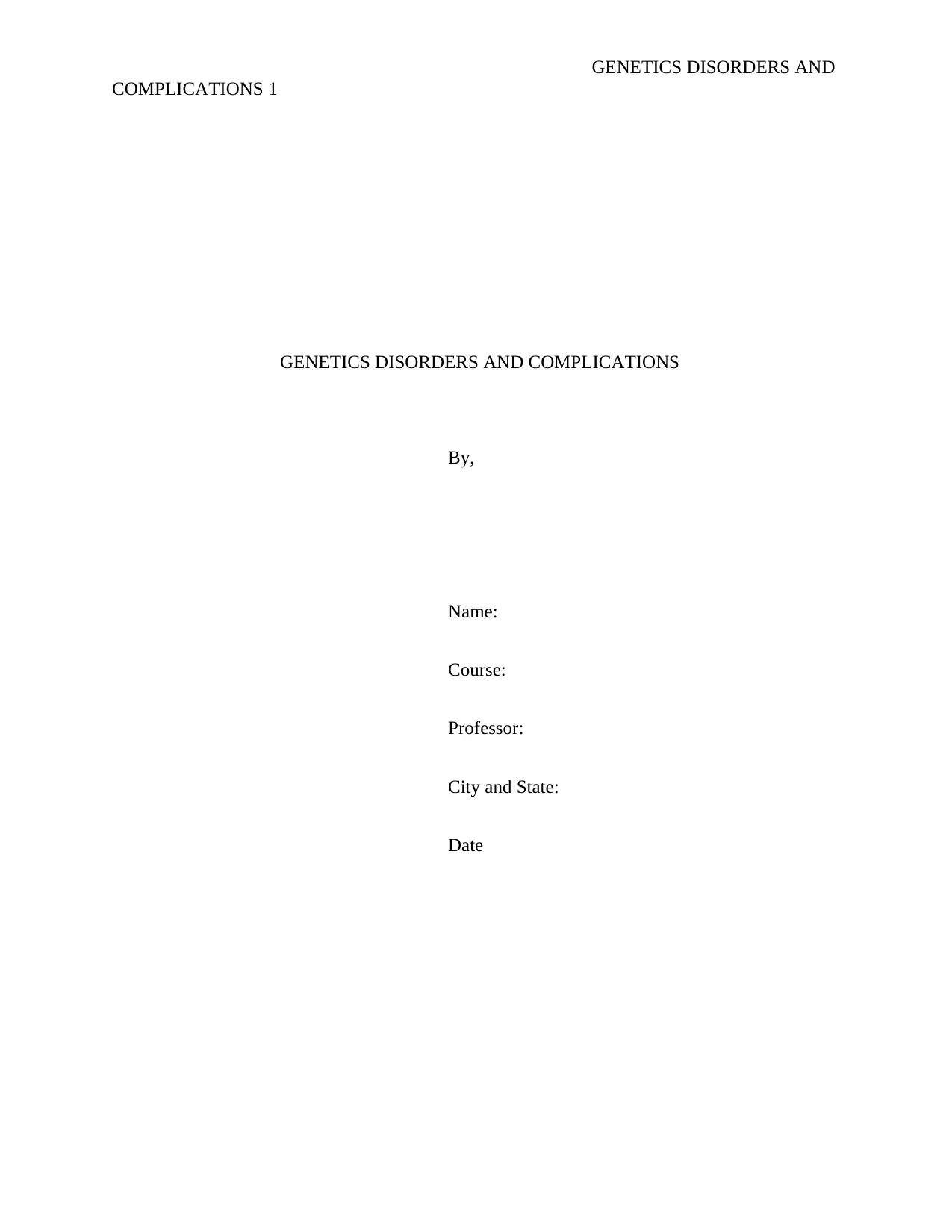
GENETICS DISORDERS AND
COMPLICATIONS 1
GENETICS DISORDERS AND COMPLICATIONS
By,
Name:
Course:
Professor:
City and State:
Date
COMPLICATIONS 1
GENETICS DISORDERS AND COMPLICATIONS
By,
Name:
Course:
Professor:
City and State:
Date
Paraphrase This Document
Need a fresh take? Get an instant paraphrase of this document with our AI Paraphraser
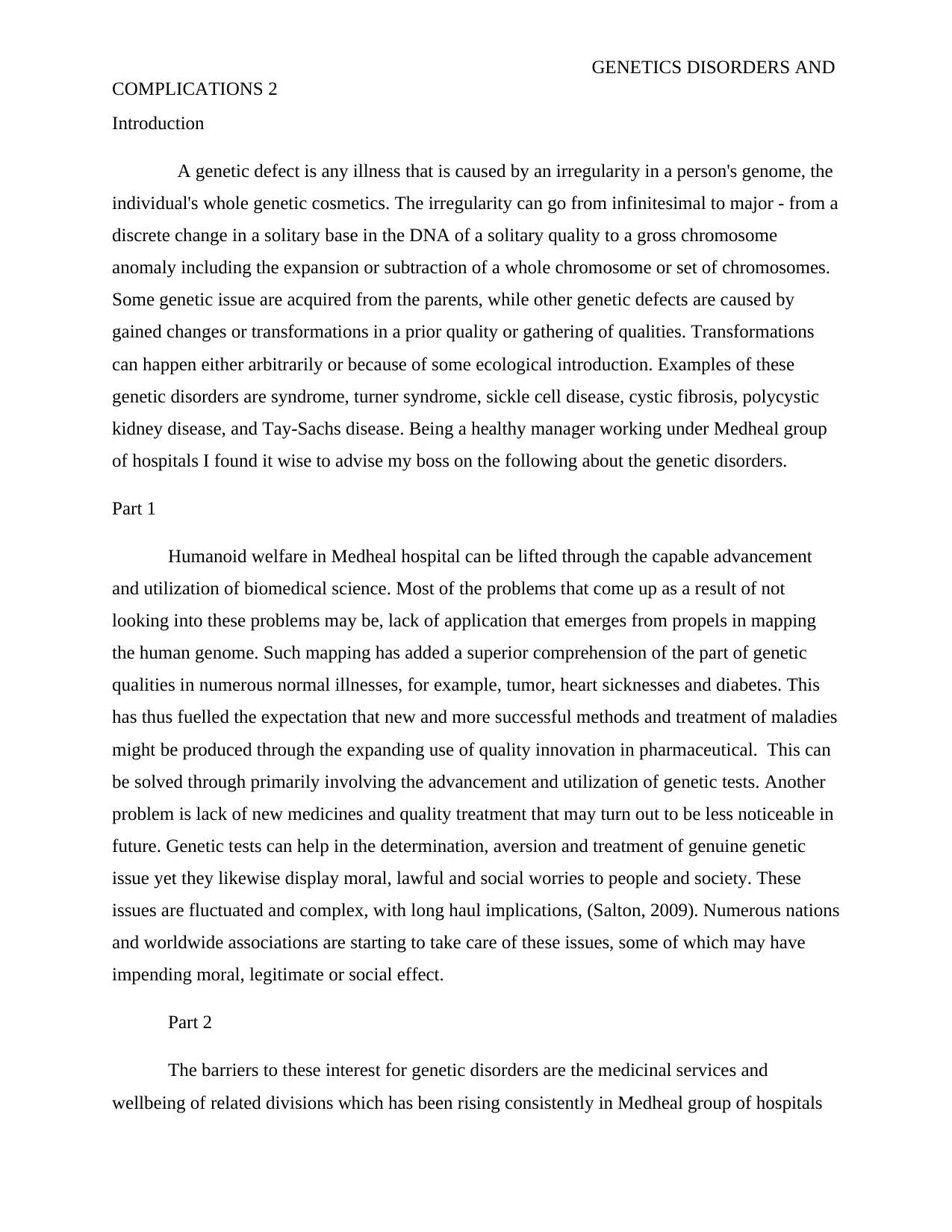
GENETICS DISORDERS AND
COMPLICATIONS 2
Introduction
A genetic defect is any illness that is caused by an irregularity in a person's genome, the
individual's whole genetic cosmetics. The irregularity can go from infinitesimal to major - from a
discrete change in a solitary base in the DNA of a solitary quality to a gross chromosome
anomaly including the expansion or subtraction of a whole chromosome or set of chromosomes.
Some genetic issue are acquired from the parents, while other genetic defects are caused by
gained changes or transformations in a prior quality or gathering of qualities. Transformations
can happen either arbitrarily or because of some ecological introduction. Examples of these
genetic disorders are syndrome, turner syndrome, sickle cell disease, cystic fibrosis, polycystic
kidney disease, and Tay-Sachs disease. Being a healthy manager working under Medheal group
of hospitals I found it wise to advise my boss on the following about the genetic disorders.
Part 1
Humanoid welfare in Medheal hospital can be lifted through the capable advancement
and utilization of biomedical science. Most of the problems that come up as a result of not
looking into these problems may be, lack of application that emerges from propels in mapping
the human genome. Such mapping has added a superior comprehension of the part of genetic
qualities in numerous normal illnesses, for example, tumor, heart sicknesses and diabetes. This
has thus fuelled the expectation that new and more successful methods and treatment of maladies
might be produced through the expanding use of quality innovation in pharmaceutical. This can
be solved through primarily involving the advancement and utilization of genetic tests. Another
problem is lack of new medicines and quality treatment that may turn out to be less noticeable in
future. Genetic tests can help in the determination, aversion and treatment of genuine genetic
issue yet they likewise display moral, lawful and social worries to people and society. These
issues are fluctuated and complex, with long haul implications, (Salton, 2009). Numerous nations
and worldwide associations are starting to take care of these issues, some of which may have
impending moral, legitimate or social effect.
Part 2
The barriers to these interest for genetic disorders are the medicinal services and
wellbeing of related divisions which has been rising consistently in Medheal group of hospitals
COMPLICATIONS 2
Introduction
A genetic defect is any illness that is caused by an irregularity in a person's genome, the
individual's whole genetic cosmetics. The irregularity can go from infinitesimal to major - from a
discrete change in a solitary base in the DNA of a solitary quality to a gross chromosome
anomaly including the expansion or subtraction of a whole chromosome or set of chromosomes.
Some genetic issue are acquired from the parents, while other genetic defects are caused by
gained changes or transformations in a prior quality or gathering of qualities. Transformations
can happen either arbitrarily or because of some ecological introduction. Examples of these
genetic disorders are syndrome, turner syndrome, sickle cell disease, cystic fibrosis, polycystic
kidney disease, and Tay-Sachs disease. Being a healthy manager working under Medheal group
of hospitals I found it wise to advise my boss on the following about the genetic disorders.
Part 1
Humanoid welfare in Medheal hospital can be lifted through the capable advancement
and utilization of biomedical science. Most of the problems that come up as a result of not
looking into these problems may be, lack of application that emerges from propels in mapping
the human genome. Such mapping has added a superior comprehension of the part of genetic
qualities in numerous normal illnesses, for example, tumor, heart sicknesses and diabetes. This
has thus fuelled the expectation that new and more successful methods and treatment of maladies
might be produced through the expanding use of quality innovation in pharmaceutical. This can
be solved through primarily involving the advancement and utilization of genetic tests. Another
problem is lack of new medicines and quality treatment that may turn out to be less noticeable in
future. Genetic tests can help in the determination, aversion and treatment of genuine genetic
issue yet they likewise display moral, lawful and social worries to people and society. These
issues are fluctuated and complex, with long haul implications, (Salton, 2009). Numerous nations
and worldwide associations are starting to take care of these issues, some of which may have
impending moral, legitimate or social effect.
Part 2
The barriers to these interest for genetic disorders are the medicinal services and
wellbeing of related divisions which has been rising consistently in Medheal group of hospitals
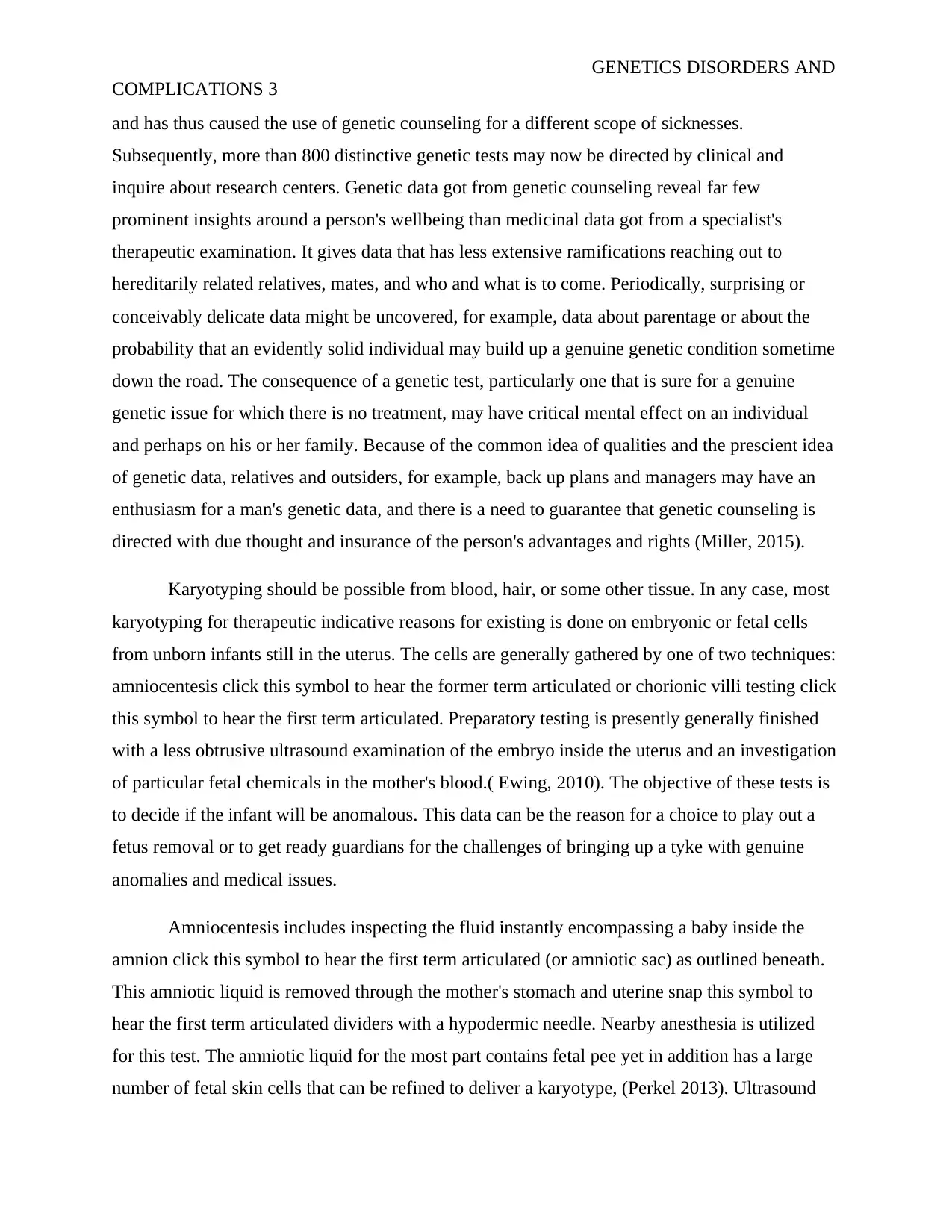
GENETICS DISORDERS AND
COMPLICATIONS 3
and has thus caused the use of genetic counseling for a different scope of sicknesses.
Subsequently, more than 800 distinctive genetic tests may now be directed by clinical and
inquire about research centers. Genetic data got from genetic counseling reveal far few
prominent insights around a person's wellbeing than medicinal data got from a specialist's
therapeutic examination. It gives data that has less extensive ramifications reaching out to
hereditarily related relatives, mates, and who and what is to come. Periodically, surprising or
conceivably delicate data might be uncovered, for example, data about parentage or about the
probability that an evidently solid individual may build up a genuine genetic condition sometime
down the road. The consequence of a genetic test, particularly one that is sure for a genuine
genetic issue for which there is no treatment, may have critical mental effect on an individual
and perhaps on his or her family. Because of the common idea of qualities and the prescient idea
of genetic data, relatives and outsiders, for example, back up plans and managers may have an
enthusiasm for a man's genetic data, and there is a need to guarantee that genetic counseling is
directed with due thought and insurance of the person's advantages and rights (Miller, 2015).
Karyotyping should be possible from blood, hair, or some other tissue. In any case, most
karyotyping for therapeutic indicative reasons for existing is done on embryonic or fetal cells
from unborn infants still in the uterus. The cells are generally gathered by one of two techniques:
amniocentesis click this symbol to hear the former term articulated or chorionic villi testing click
this symbol to hear the first term articulated. Preparatory testing is presently generally finished
with a less obtrusive ultrasound examination of the embryo inside the uterus and an investigation
of particular fetal chemicals in the mother's blood.( Ewing, 2010). The objective of these tests is
to decide if the infant will be anomalous. This data can be the reason for a choice to play out a
fetus removal or to get ready guardians for the challenges of bringing up a tyke with genuine
anomalies and medical issues.
Amniocentesis includes inspecting the fluid instantly encompassing a baby inside the
amnion click this symbol to hear the first term articulated (or amniotic sac) as outlined beneath.
This amniotic liquid is removed through the mother's stomach and uterine snap this symbol to
hear the first term articulated dividers with a hypodermic needle. Nearby anesthesia is utilized
for this test. The amniotic liquid for the most part contains fetal pee yet in addition has a large
number of fetal skin cells that can be refined to deliver a karyotype, (Perkel 2013). Ultrasound
COMPLICATIONS 3
and has thus caused the use of genetic counseling for a different scope of sicknesses.
Subsequently, more than 800 distinctive genetic tests may now be directed by clinical and
inquire about research centers. Genetic data got from genetic counseling reveal far few
prominent insights around a person's wellbeing than medicinal data got from a specialist's
therapeutic examination. It gives data that has less extensive ramifications reaching out to
hereditarily related relatives, mates, and who and what is to come. Periodically, surprising or
conceivably delicate data might be uncovered, for example, data about parentage or about the
probability that an evidently solid individual may build up a genuine genetic condition sometime
down the road. The consequence of a genetic test, particularly one that is sure for a genuine
genetic issue for which there is no treatment, may have critical mental effect on an individual
and perhaps on his or her family. Because of the common idea of qualities and the prescient idea
of genetic data, relatives and outsiders, for example, back up plans and managers may have an
enthusiasm for a man's genetic data, and there is a need to guarantee that genetic counseling is
directed with due thought and insurance of the person's advantages and rights (Miller, 2015).
Karyotyping should be possible from blood, hair, or some other tissue. In any case, most
karyotyping for therapeutic indicative reasons for existing is done on embryonic or fetal cells
from unborn infants still in the uterus. The cells are generally gathered by one of two techniques:
amniocentesis click this symbol to hear the former term articulated or chorionic villi testing click
this symbol to hear the first term articulated. Preparatory testing is presently generally finished
with a less obtrusive ultrasound examination of the embryo inside the uterus and an investigation
of particular fetal chemicals in the mother's blood.( Ewing, 2010). The objective of these tests is
to decide if the infant will be anomalous. This data can be the reason for a choice to play out a
fetus removal or to get ready guardians for the challenges of bringing up a tyke with genuine
anomalies and medical issues.
Amniocentesis includes inspecting the fluid instantly encompassing a baby inside the
amnion click this symbol to hear the first term articulated (or amniotic sac) as outlined beneath.
This amniotic liquid is removed through the mother's stomach and uterine snap this symbol to
hear the first term articulated dividers with a hypodermic needle. Nearby anesthesia is utilized
for this test. The amniotic liquid for the most part contains fetal pee yet in addition has a large
number of fetal skin cells that can be refined to deliver a karyotype, (Perkel 2013). Ultrasound
⊘ This is a preview!⊘
Do you want full access?
Subscribe today to unlock all pages.

Trusted by 1+ million students worldwide
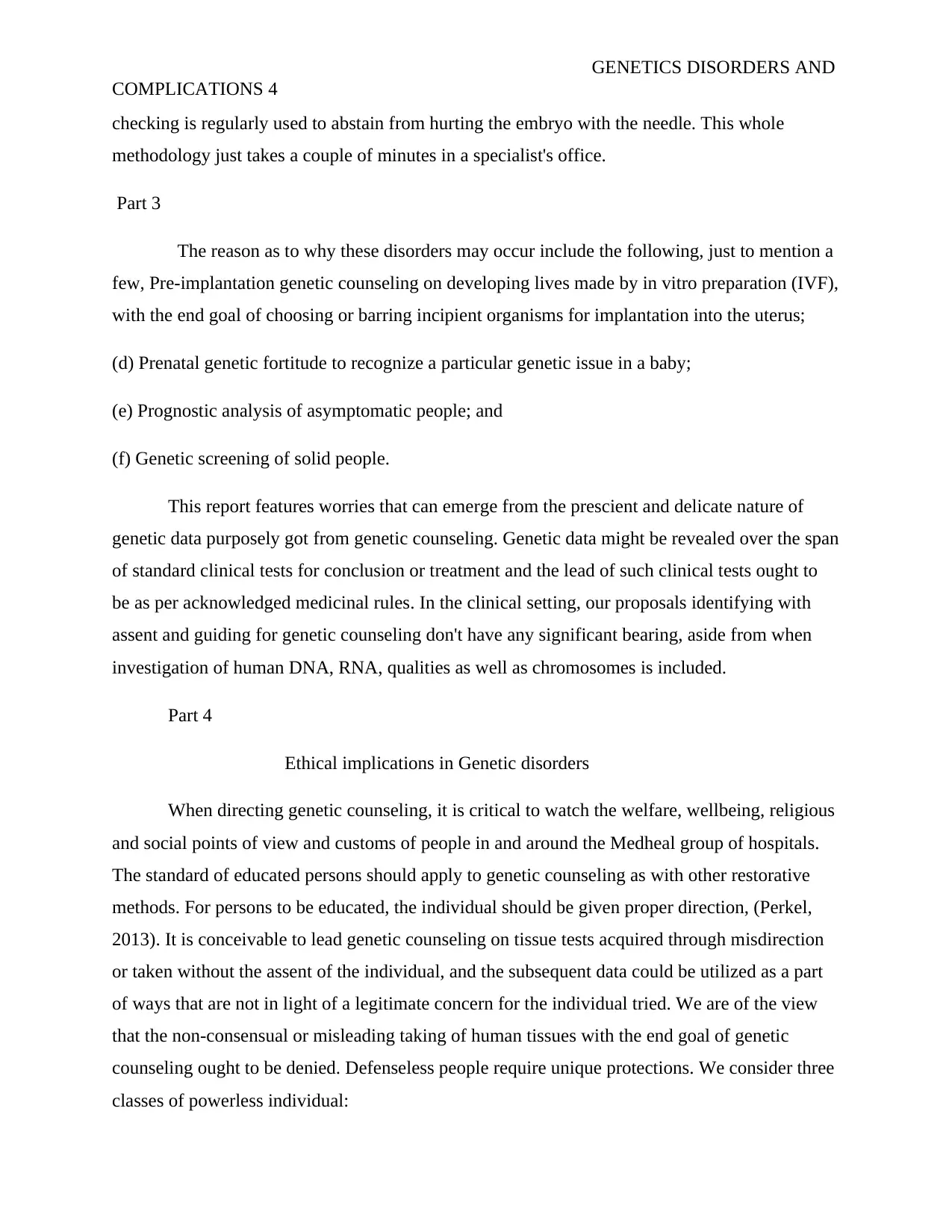
GENETICS DISORDERS AND
COMPLICATIONS 4
checking is regularly used to abstain from hurting the embryo with the needle. This whole
methodology just takes a couple of minutes in a specialist's office.
Part 3
The reason as to why these disorders may occur include the following, just to mention a
few, Pre-implantation genetic counseling on developing lives made by in vitro preparation (IVF),
with the end goal of choosing or barring incipient organisms for implantation into the uterus;
(d) Prenatal genetic fortitude to recognize a particular genetic issue in a baby;
(e) Prognostic analysis of asymptomatic people; and
(f) Genetic screening of solid people.
This report features worries that can emerge from the prescient and delicate nature of
genetic data purposely got from genetic counseling. Genetic data might be revealed over the span
of standard clinical tests for conclusion or treatment and the lead of such clinical tests ought to
be as per acknowledged medicinal rules. In the clinical setting, our proposals identifying with
assent and guiding for genetic counseling don't have any significant bearing, aside from when
investigation of human DNA, RNA, qualities as well as chromosomes is included.
Part 4
Ethical implications in Genetic disorders
When directing genetic counseling, it is critical to watch the welfare, wellbeing, religious
and social points of view and customs of people in and around the Medheal group of hospitals.
The standard of educated persons should apply to genetic counseling as with other restorative
methods. For persons to be educated, the individual should be given proper direction, (Perkel,
2013). It is conceivable to lead genetic counseling on tissue tests acquired through misdirection
or taken without the assent of the individual, and the subsequent data could be utilized as a part
of ways that are not in light of a legitimate concern for the individual tried. We are of the view
that the non-consensual or misleading taking of human tissues with the end goal of genetic
counseling ought to be denied. Defenseless people require unique protections. We consider three
classes of powerless individual:
COMPLICATIONS 4
checking is regularly used to abstain from hurting the embryo with the needle. This whole
methodology just takes a couple of minutes in a specialist's office.
Part 3
The reason as to why these disorders may occur include the following, just to mention a
few, Pre-implantation genetic counseling on developing lives made by in vitro preparation (IVF),
with the end goal of choosing or barring incipient organisms for implantation into the uterus;
(d) Prenatal genetic fortitude to recognize a particular genetic issue in a baby;
(e) Prognostic analysis of asymptomatic people; and
(f) Genetic screening of solid people.
This report features worries that can emerge from the prescient and delicate nature of
genetic data purposely got from genetic counseling. Genetic data might be revealed over the span
of standard clinical tests for conclusion or treatment and the lead of such clinical tests ought to
be as per acknowledged medicinal rules. In the clinical setting, our proposals identifying with
assent and guiding for genetic counseling don't have any significant bearing, aside from when
investigation of human DNA, RNA, qualities as well as chromosomes is included.
Part 4
Ethical implications in Genetic disorders
When directing genetic counseling, it is critical to watch the welfare, wellbeing, religious
and social points of view and customs of people in and around the Medheal group of hospitals.
The standard of educated persons should apply to genetic counseling as with other restorative
methods. For persons to be educated, the individual should be given proper direction, (Perkel,
2013). It is conceivable to lead genetic counseling on tissue tests acquired through misdirection
or taken without the assent of the individual, and the subsequent data could be utilized as a part
of ways that are not in light of a legitimate concern for the individual tried. We are of the view
that the non-consensual or misleading taking of human tissues with the end goal of genetic
counseling ought to be denied. Defenseless people require unique protections. We consider three
classes of powerless individual:
Paraphrase This Document
Need a fresh take? Get an instant paraphrase of this document with our AI Paraphraser
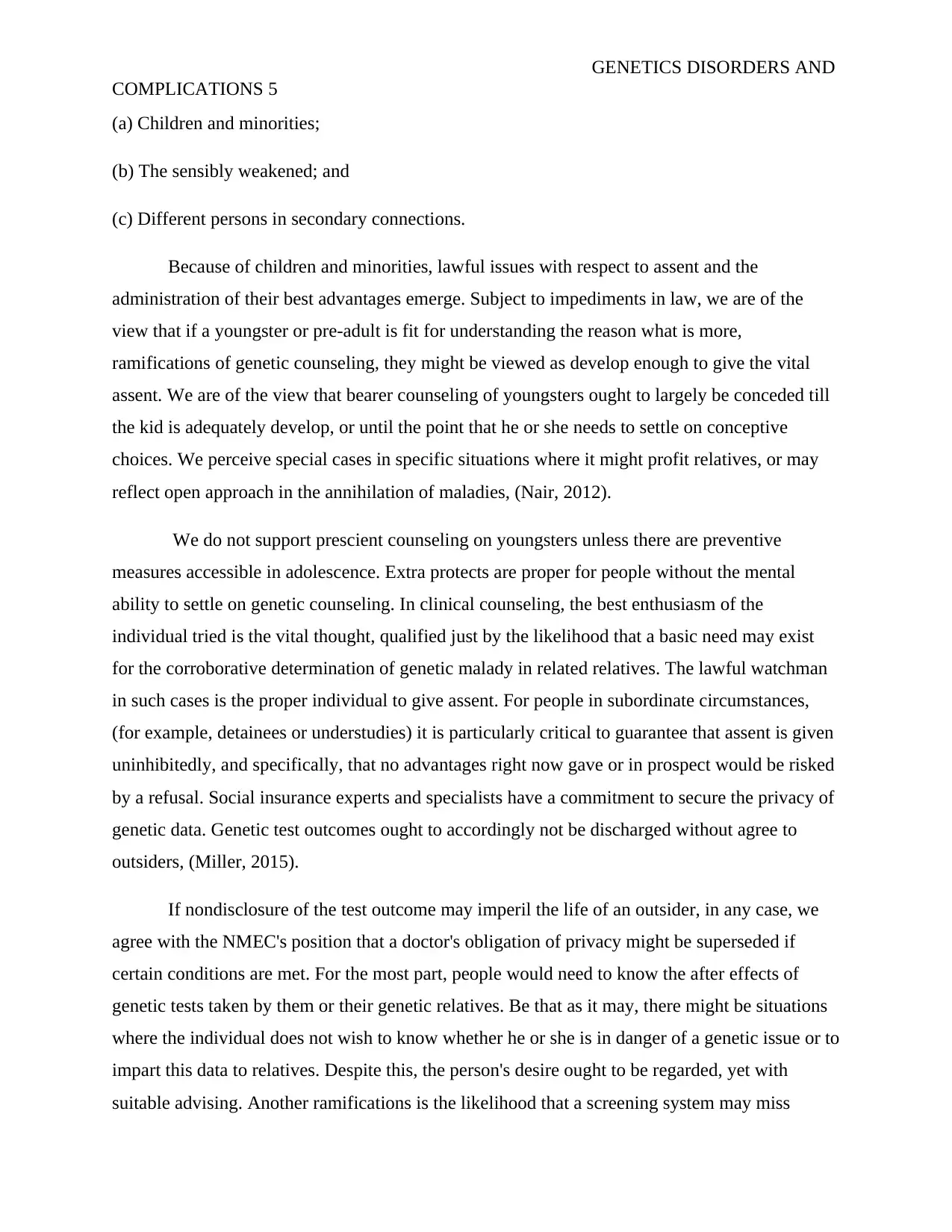
GENETICS DISORDERS AND
COMPLICATIONS 5
(a) Children and minorities;
(b) The sensibly weakened; and
(c) Different persons in secondary connections.
Because of children and minorities, lawful issues with respect to assent and the
administration of their best advantages emerge. Subject to impediments in law, we are of the
view that if a youngster or pre-adult is fit for understanding the reason what is more,
ramifications of genetic counseling, they might be viewed as develop enough to give the vital
assent. We are of the view that bearer counseling of youngsters ought to largely be conceded till
the kid is adequately develop, or until the point that he or she needs to settle on conceptive
choices. We perceive special cases in specific situations where it might profit relatives, or may
reflect open approach in the annihilation of maladies, (Nair, 2012).
We do not support prescient counseling on youngsters unless there are preventive
measures accessible in adolescence. Extra protects are proper for people without the mental
ability to settle on genetic counseling. In clinical counseling, the best enthusiasm of the
individual tried is the vital thought, qualified just by the likelihood that a basic need may exist
for the corroborative determination of genetic malady in related relatives. The lawful watchman
in such cases is the proper individual to give assent. For people in subordinate circumstances,
(for example, detainees or understudies) it is particularly critical to guarantee that assent is given
uninhibitedly, and specifically, that no advantages right now gave or in prospect would be risked
by a refusal. Social insurance experts and specialists have a commitment to secure the privacy of
genetic data. Genetic test outcomes ought to accordingly not be discharged without agree to
outsiders, (Miller, 2015).
If nondisclosure of the test outcome may imperil the life of an outsider, in any case, we
agree with the NMEC's position that a doctor's obligation of privacy might be superseded if
certain conditions are met. For the most part, people would need to know the after effects of
genetic tests taken by them or their genetic relatives. Be that as it may, there might be situations
where the individual does not wish to know whether he or she is in danger of a genetic issue or to
impart this data to relatives. Despite this, the person's desire ought to be regarded, yet with
suitable advising. Another ramifications is the likelihood that a screening system may miss
COMPLICATIONS 5
(a) Children and minorities;
(b) The sensibly weakened; and
(c) Different persons in secondary connections.
Because of children and minorities, lawful issues with respect to assent and the
administration of their best advantages emerge. Subject to impediments in law, we are of the
view that if a youngster or pre-adult is fit for understanding the reason what is more,
ramifications of genetic counseling, they might be viewed as develop enough to give the vital
assent. We are of the view that bearer counseling of youngsters ought to largely be conceded till
the kid is adequately develop, or until the point that he or she needs to settle on conceptive
choices. We perceive special cases in specific situations where it might profit relatives, or may
reflect open approach in the annihilation of maladies, (Nair, 2012).
We do not support prescient counseling on youngsters unless there are preventive
measures accessible in adolescence. Extra protects are proper for people without the mental
ability to settle on genetic counseling. In clinical counseling, the best enthusiasm of the
individual tried is the vital thought, qualified just by the likelihood that a basic need may exist
for the corroborative determination of genetic malady in related relatives. The lawful watchman
in such cases is the proper individual to give assent. For people in subordinate circumstances,
(for example, detainees or understudies) it is particularly critical to guarantee that assent is given
uninhibitedly, and specifically, that no advantages right now gave or in prospect would be risked
by a refusal. Social insurance experts and specialists have a commitment to secure the privacy of
genetic data. Genetic test outcomes ought to accordingly not be discharged without agree to
outsiders, (Miller, 2015).
If nondisclosure of the test outcome may imperil the life of an outsider, in any case, we
agree with the NMEC's position that a doctor's obligation of privacy might be superseded if
certain conditions are met. For the most part, people would need to know the after effects of
genetic tests taken by them or their genetic relatives. Be that as it may, there might be situations
where the individual does not wish to know whether he or she is in danger of a genetic issue or to
impart this data to relatives. Despite this, the person's desire ought to be regarded, yet with
suitable advising. Another ramifications is the likelihood that a screening system may miss
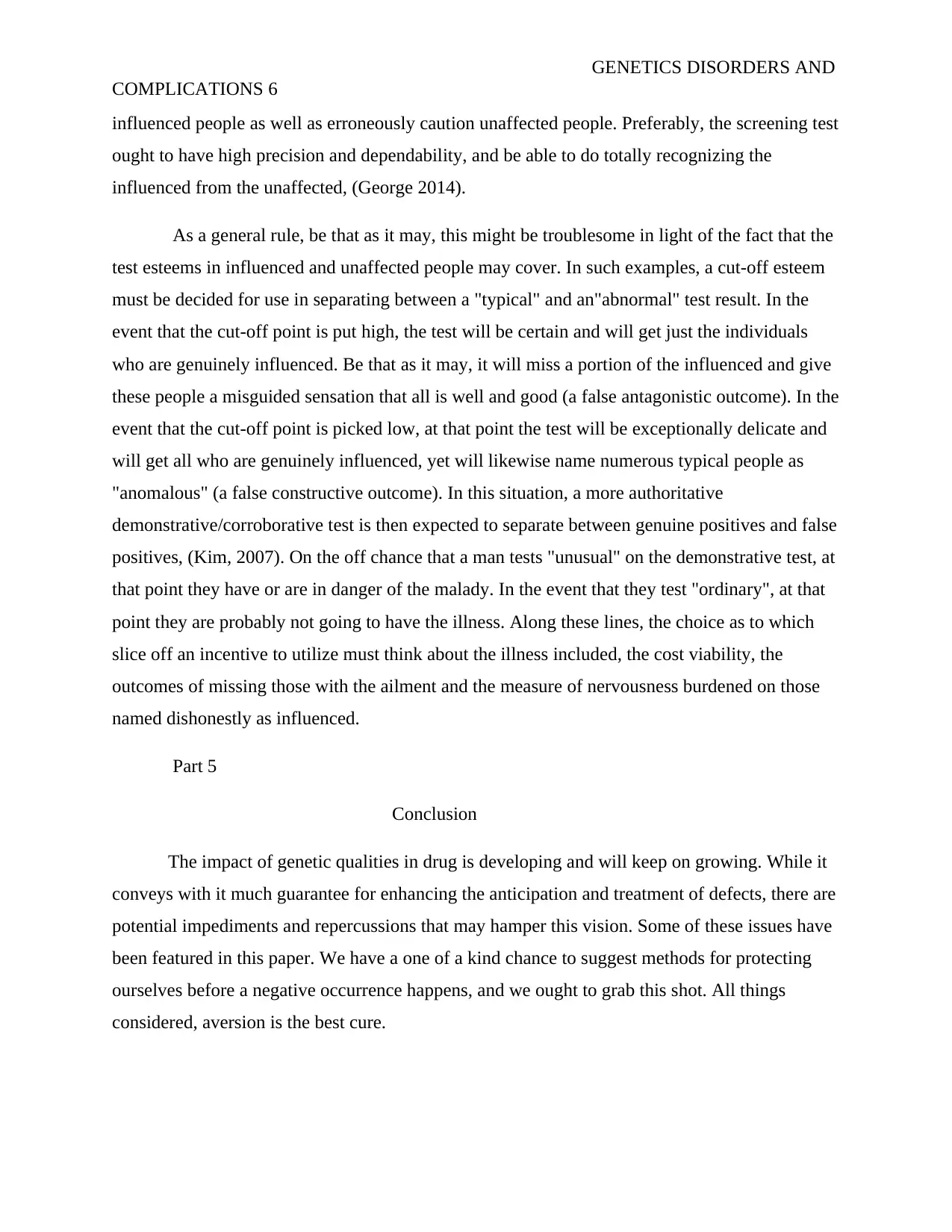
GENETICS DISORDERS AND
COMPLICATIONS 6
influenced people as well as erroneously caution unaffected people. Preferably, the screening test
ought to have high precision and dependability, and be able to do totally recognizing the
influenced from the unaffected, (George 2014).
As a general rule, be that as it may, this might be troublesome in light of the fact that the
test esteems in influenced and unaffected people may cover. In such examples, a cut-off esteem
must be decided for use in separating between a "typical" and an"abnormal" test result. In the
event that the cut-off point is put high, the test will be certain and will get just the individuals
who are genuinely influenced. Be that as it may, it will miss a portion of the influenced and give
these people a misguided sensation that all is well and good (a false antagonistic outcome). In the
event that the cut-off point is picked low, at that point the test will be exceptionally delicate and
will get all who are genuinely influenced, yet will likewise name numerous typical people as
"anomalous" (a false constructive outcome). In this situation, a more authoritative
demonstrative/corroborative test is then expected to separate between genuine positives and false
positives, (Kim, 2007). On the off chance that a man tests "unusual" on the demonstrative test, at
that point they have or are in danger of the malady. In the event that they test "ordinary", at that
point they are probably not going to have the illness. Along these lines, the choice as to which
slice off an incentive to utilize must think about the illness included, the cost viability, the
outcomes of missing those with the ailment and the measure of nervousness burdened on those
named dishonestly as influenced.
Part 5
Conclusion
The impact of genetic qualities in drug is developing and will keep on growing. While it
conveys with it much guarantee for enhancing the anticipation and treatment of defects, there are
potential impediments and repercussions that may hamper this vision. Some of these issues have
been featured in this paper. We have a one of a kind chance to suggest methods for protecting
ourselves before a negative occurrence happens, and we ought to grab this shot. All things
considered, aversion is the best cure.
COMPLICATIONS 6
influenced people as well as erroneously caution unaffected people. Preferably, the screening test
ought to have high precision and dependability, and be able to do totally recognizing the
influenced from the unaffected, (George 2014).
As a general rule, be that as it may, this might be troublesome in light of the fact that the
test esteems in influenced and unaffected people may cover. In such examples, a cut-off esteem
must be decided for use in separating between a "typical" and an"abnormal" test result. In the
event that the cut-off point is put high, the test will be certain and will get just the individuals
who are genuinely influenced. Be that as it may, it will miss a portion of the influenced and give
these people a misguided sensation that all is well and good (a false antagonistic outcome). In the
event that the cut-off point is picked low, at that point the test will be exceptionally delicate and
will get all who are genuinely influenced, yet will likewise name numerous typical people as
"anomalous" (a false constructive outcome). In this situation, a more authoritative
demonstrative/corroborative test is then expected to separate between genuine positives and false
positives, (Kim, 2007). On the off chance that a man tests "unusual" on the demonstrative test, at
that point they have or are in danger of the malady. In the event that they test "ordinary", at that
point they are probably not going to have the illness. Along these lines, the choice as to which
slice off an incentive to utilize must think about the illness included, the cost viability, the
outcomes of missing those with the ailment and the measure of nervousness burdened on those
named dishonestly as influenced.
Part 5
Conclusion
The impact of genetic qualities in drug is developing and will keep on growing. While it
conveys with it much guarantee for enhancing the anticipation and treatment of defects, there are
potential impediments and repercussions that may hamper this vision. Some of these issues have
been featured in this paper. We have a one of a kind chance to suggest methods for protecting
ourselves before a negative occurrence happens, and we ought to grab this shot. All things
considered, aversion is the best cure.
⊘ This is a preview!⊘
Do you want full access?
Subscribe today to unlock all pages.

Trusted by 1+ million students worldwide
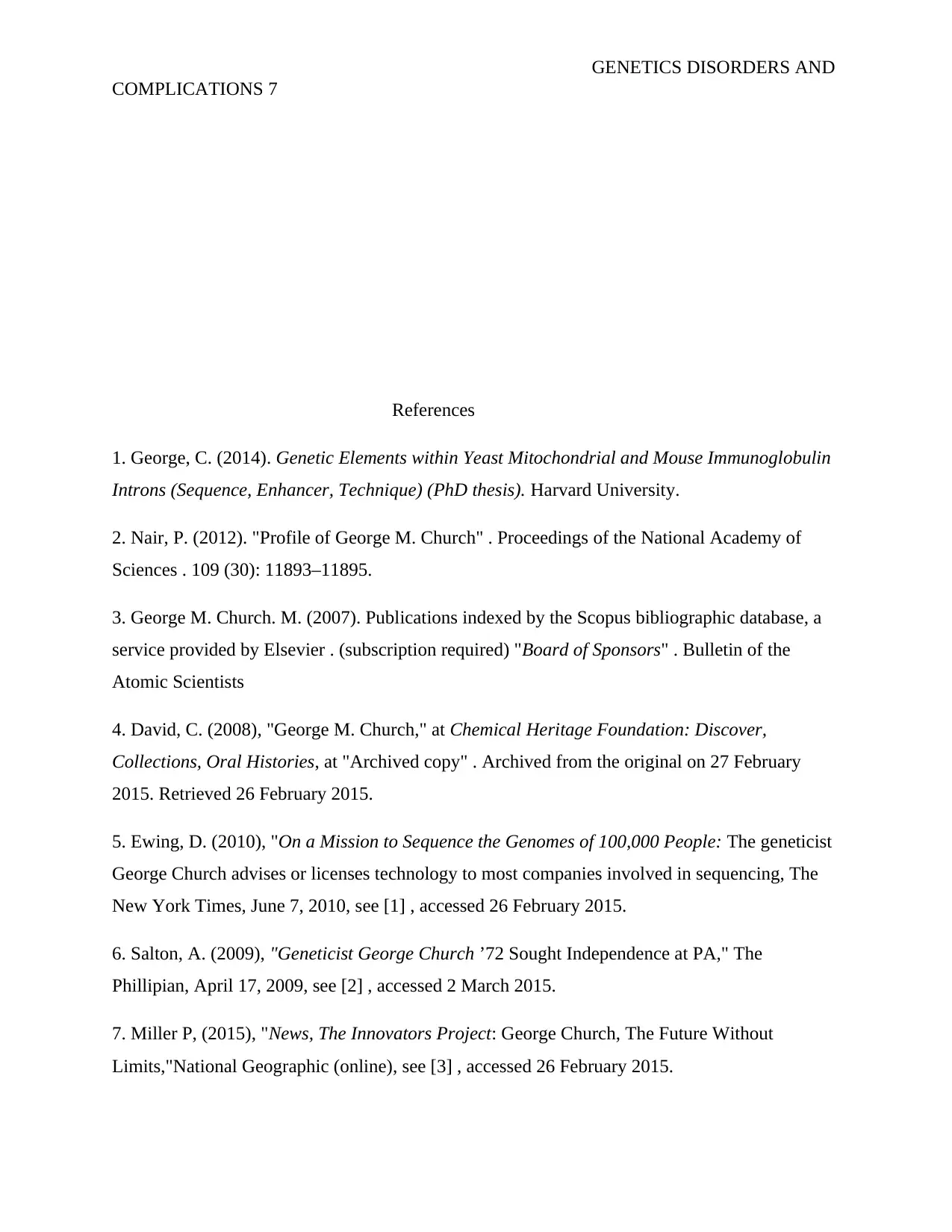
GENETICS DISORDERS AND
COMPLICATIONS 7
References
1. George, C. (2014). Genetic Elements within Yeast Mitochondrial and Mouse Immunoglobulin
Introns (Sequence, Enhancer, Technique) (PhD thesis). Harvard University.
2. Nair, P. (2012). "Profile of George M. Church" . Proceedings of the National Academy of
Sciences . 109 (30): 11893–11895.
3. George M. Church. M. (2007). Publications indexed by the Scopus bibliographic database, a
service provided by Elsevier . (subscription required) "Board of Sponsors" . Bulletin of the
Atomic Scientists
4. David, C. (2008), "George M. Church," at Chemical Heritage Foundation: Discover,
Collections, Oral Histories, at "Archived copy" . Archived from the original on 27 February
2015. Retrieved 26 February 2015.
5. Ewing, D. (2010), "On a Mission to Sequence the Genomes of 100,000 People: The geneticist
George Church advises or licenses technology to most companies involved in sequencing, The
New York Times, June 7, 2010, see [1] , accessed 26 February 2015.
6. Salton, A. (2009), "Geneticist George Church ’72 Sought Independence at PA," The
Phillipian, April 17, 2009, see [2] , accessed 2 March 2015.
7. Miller P, (2015), "News, The Innovators Project: George Church, The Future Without
Limits,"National Geographic (online), see [3] , accessed 26 February 2015.
COMPLICATIONS 7
References
1. George, C. (2014). Genetic Elements within Yeast Mitochondrial and Mouse Immunoglobulin
Introns (Sequence, Enhancer, Technique) (PhD thesis). Harvard University.
2. Nair, P. (2012). "Profile of George M. Church" . Proceedings of the National Academy of
Sciences . 109 (30): 11893–11895.
3. George M. Church. M. (2007). Publications indexed by the Scopus bibliographic database, a
service provided by Elsevier . (subscription required) "Board of Sponsors" . Bulletin of the
Atomic Scientists
4. David, C. (2008), "George M. Church," at Chemical Heritage Foundation: Discover,
Collections, Oral Histories, at "Archived copy" . Archived from the original on 27 February
2015. Retrieved 26 February 2015.
5. Ewing, D. (2010), "On a Mission to Sequence the Genomes of 100,000 People: The geneticist
George Church advises or licenses technology to most companies involved in sequencing, The
New York Times, June 7, 2010, see [1] , accessed 26 February 2015.
6. Salton, A. (2009), "Geneticist George Church ’72 Sought Independence at PA," The
Phillipian, April 17, 2009, see [2] , accessed 2 March 2015.
7. Miller P, (2015), "News, The Innovators Project: George Church, The Future Without
Limits,"National Geographic (online), see [3] , accessed 26 February 2015.
Paraphrase This Document
Need a fresh take? Get an instant paraphrase of this document with our AI Paraphraser
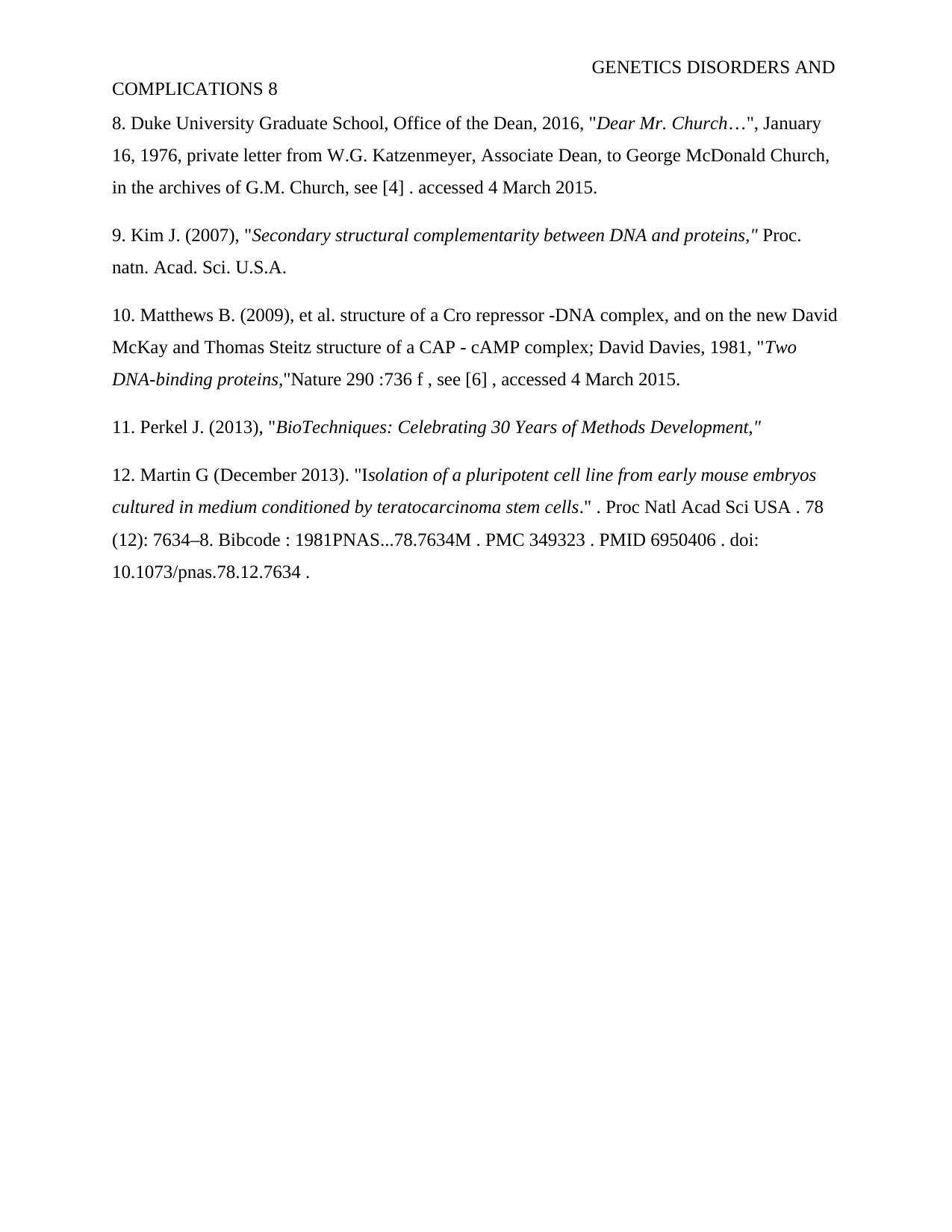
GENETICS DISORDERS AND
COMPLICATIONS 8
8. Duke University Graduate School, Office of the Dean, 2016, "Dear Mr. Church…", January
16, 1976, private letter from W.G. Katzenmeyer, Associate Dean, to George McDonald Church,
in the archives of G.M. Church, see [4] . accessed 4 March 2015.
9. Kim J. (2007), "Secondary structural complementarity between DNA and proteins," Proc.
natn. Acad. Sci. U.S.A.
10. Matthews B. (2009), et al. structure of a Cro repressor -DNA complex, and on the new David
McKay and Thomas Steitz structure of a CAP - cAMP complex; David Davies, 1981, "Two
DNA-binding proteins,"Nature 290 :736 f , see [6] , accessed 4 March 2015.
11. Perkel J. (2013), "BioTechniques: Celebrating 30 Years of Methods Development,"
12. Martin G (December 2013). "Isolation of a pluripotent cell line from early mouse embryos
cultured in medium conditioned by teratocarcinoma stem cells." . Proc Natl Acad Sci USA . 78
(12): 7634–8. Bibcode : 1981PNAS...78.7634M . PMC 349323 . PMID 6950406 . doi:
10.1073/pnas.78.12.7634 .
COMPLICATIONS 8
8. Duke University Graduate School, Office of the Dean, 2016, "Dear Mr. Church…", January
16, 1976, private letter from W.G. Katzenmeyer, Associate Dean, to George McDonald Church,
in the archives of G.M. Church, see [4] . accessed 4 March 2015.
9. Kim J. (2007), "Secondary structural complementarity between DNA and proteins," Proc.
natn. Acad. Sci. U.S.A.
10. Matthews B. (2009), et al. structure of a Cro repressor -DNA complex, and on the new David
McKay and Thomas Steitz structure of a CAP - cAMP complex; David Davies, 1981, "Two
DNA-binding proteins,"Nature 290 :736 f , see [6] , accessed 4 March 2015.
11. Perkel J. (2013), "BioTechniques: Celebrating 30 Years of Methods Development,"
12. Martin G (December 2013). "Isolation of a pluripotent cell line from early mouse embryos
cultured in medium conditioned by teratocarcinoma stem cells." . Proc Natl Acad Sci USA . 78
(12): 7634–8. Bibcode : 1981PNAS...78.7634M . PMC 349323 . PMID 6950406 . doi:
10.1073/pnas.78.12.7634 .
1 out of 8
Your All-in-One AI-Powered Toolkit for Academic Success.
+13062052269
info@desklib.com
Available 24*7 on WhatsApp / Email
![[object Object]](/_next/static/media/star-bottom.7253800d.svg)
Unlock your academic potential
Copyright © 2020–2025 A2Z Services. All Rights Reserved. Developed and managed by ZUCOL.
